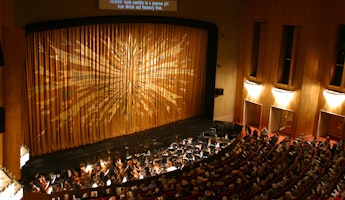Blog
August 7, 2024
From Page to Stage: "Madame Butterfly"
It’s hard to believe, but in just over a month we’ll be celebrating the opening of our 2024/25 season. We have the pleasure of starting the season with Giacomo Puccini’s Madame Butterfly, after closing the past season with another Puccini classic, Turandot.
Butterfly is one of the most popular and frequently produced operas of the 20th century and a true testament to Puccini’s work ethic. Butterfly had quite the journey to the stage and it’s almost a miracle it became the standard it is today. From a near-death car accident to a disastrous opening night, Puccini was at a disadvantage however, nothing could deter him from finishing the opera. Let's go through the history of this beloved masterpiece.
Madame Butterfly started as a short story by John Luther Long in 1898, though his story was, in turn, based on tales that Long’s sister told him of Japan, along with influences from a semi-autobiographical 1887 French novel titled Madame Chrysanthéme by Pierre Loti. Long’s story was first brought to the stage by David Belasco in his one-act play Madame Butterfly: A Tragedy of Japan which premiered in New York in 1900. Later that year the play premiered in London, where Puccini saw it. Despite Puccini not understanding any English, he immediately felt connected to the story and asked his publisher to obtain the rights to the story.
Puccini began working on the opera in early 1901, in collaboration with his longtime librettists Luigi Illica and Giuseppe Giacosa (with whom he previously worked with on Mamon Lescaut, La Boheme and Tosca). Their opera was a faithful adaptation of Long’s original story. It is important to note that neither Long, Belasco, nor Puccini had ever been to Japan themselves and anything they thought they knew about the country was secondhand, coming from other Europeans. As a result, Madame Butterfly takes a very Eurocentric view of Japan.
Considering the time and the lack of awareness among Europeans in general, Puccini likely thought he was doing a good thing by including authentic Japanese melodies in his score, although he didn’t credit them. But we will: they include tunes called “Sakura,” “Miyasan,” “Oedo Nihonbashi” and “Kimigayo.”
The writing process of Madame Butterfly went as smoothly as you’d hope at first, until February 25, 1903, when Puccini got into a car crash. Puccini was pinned under his vehicle and saved by a doctor and another person who lived near the crash scene. He suffered a serious fracture to his femur and then discovered he was suffering from diabetes while he was being treated for his injuries. The injury and illness slowed down Puccini's creative progress. He finished the opera after his deadline and the original cast didn’t have adequate time for rehearsals for the world premiere at La Scala on February 17, 1904. This, along with the presence of Puccini’s detractors in the audience, led to a disastrous opening. Almost inconceivably, the opera’s most famous aria, “Un bel di,” was met with silence.
Puccini didn’t give up after this disastrous opening and he immediately began working on a new version. In fact, Puccini would eventually write five different versions of the opera. The second version, which notably split the original second act to make three acts, premiered on May 28, 1904, in Brescia. This version was a great success and would go on to be performed in the United States. Puccini made more revisions for the opera’s first performance at the Met Opera on February 11, 1907. Later that year, Puccini made great changes to the orchestral and choral score, making it the fourth version of the opera. The final version of the opera would come later in 1907, with minor revisions compared to the previous version. This fifth version is what has become the standard performing edition and is the one we will be presenting.
Madame Butterfly very easily could have been lost to opera history. If Puccini’s crash had been fatal, it would have remained unfinished, at least by him. And if he had not invested the time to revise his original, then it may have been considered a failure and fallen out of the repertory. Instead, the opera stood against all odds and became one of the most performed operas of the 20th century. It’s a testament to Puccini’s resilience and the opera’s profound story that continues to tear audience’s hearts to pieces, over a century after its creation.








/03-cosi/_dsc0996_pr.jpg?format=auto&fit=crop&w=345&h=200&auto=format)













